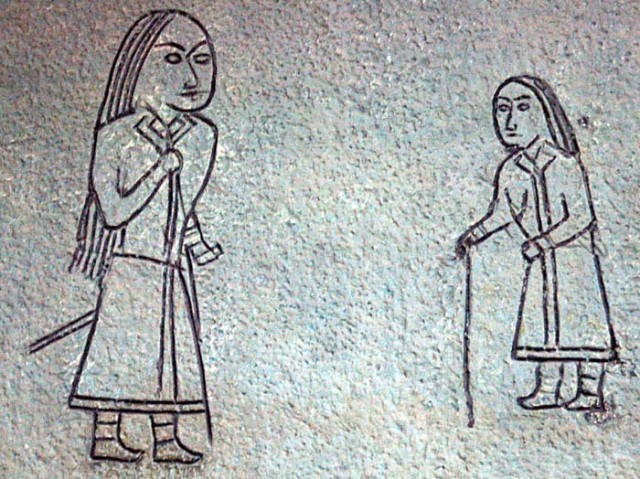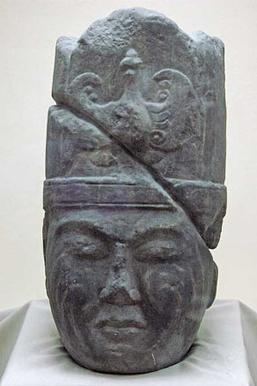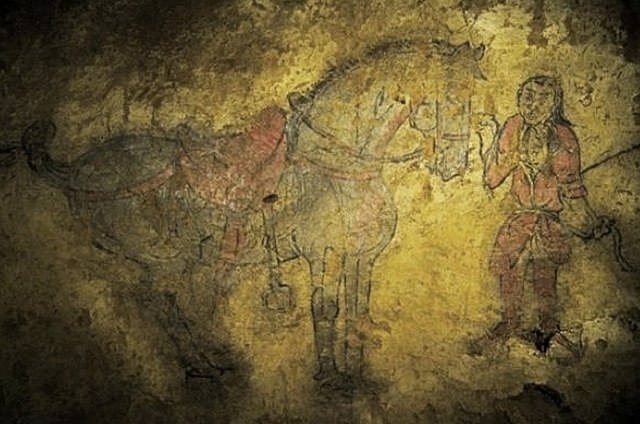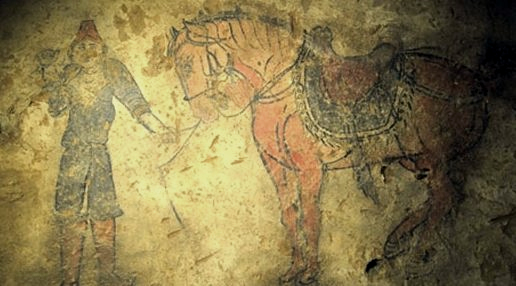
| GOKTURKS
Göktürk petroglyphs from Mongolia (6th to 8th century) Total
population : Ancestral to some Turkic population
The Göktürks, Celestial Turks or Blue Turks (Romanized: Türük Bodun; Chinese: Tujué; Wade-Giles: T'u-chüeh) were a nomadic confederation of Turkic peoples in medieval Inner Asia. The Göktürks, under the leadership of Bumin Qaghan (d. 552) and his sons, succeeded the Rouran Khaganate as the main power in the region and established the Turkic Khaganate, one of several nomadic dynasties which would shape the future geolocation, culture, and dominant beliefs of Turkic peoples.
Etymology :
Strictly speaking, the common name Göktürk is the Anatolian Turkish form of the historical ethnic group's endonym: which was attested as romanized: Türük Old Turkic: romanized: Kök Türük, or romanized: Türk. They were known in Middle Chinese historical sources as the Tujué. According to Chinese sources, Tujué meant "combat helmet" (Chinese: pinyin: Doumóu; Wade–Giles: Tou1-mou2), reportedly because the shape of the Altai Mountains where they lived, was similar to a combat helmet. Róna-Tas (1991) pointed to a Khotanese-Saka word, tturakä "lid", semantically stretchable to "helmet", as a possible source for this folk etymology, yet Golden thinks this connection requires more data.
Göktürk means "Celestial Turks", or sometimes "Blue Turks" (i.e. because sky blue is associated with celestial realms). This is consistent with "the cult of heavenly ordained rule" which was a recurrent element of Altaic political culture and as such may have been imbibed by the Göktürks from their predecessors in Mongolia. The name of the ruling Ashina clan may derive from the Khotanese Saka term for "deep blue", aššina.
The ethnonym was also recorded in various other Middle Asian languages, such as Sogdian *Türkit ~ Türküt, tr'wkt, trwkt, turkt > trwkc, trukc; Khotanese Saka Tturka, Ttruka and Old Tibetan Drugu.
The ethnonym Türük/Törük, possibly means "created", "born", from the Old Turkic word root *türi-/töri- ("tribal root, (mythic) ancestry; take shape, to be born, be created, arise, spring up") and conjugated with Old Turkic suffix (-ik), perhaps from Proto-Turkic *türi-k ("lineage, ancestry"), (compare also Proto-Turkic root *töre- "to be born, originate")
According to American Heritage Dictionary the word Türk meant "strong" in Old Turkic; though Gerhard Doerfer supports this theory, Gerard Clauson points out that "the word türk is never used in the generalized sense of 'strong'" and that the noun türk originally meant "'the culminating point of maturity' (of a fruit, human being, etc.), but more often used as an [adjective] meaning (of a fruit) 'just fully ripe'; (of a human being) 'in the prime of life, young, and vigorous'".
Origins :
The Göktürk rulers originated from the Ashina clan, who were first attested to 439. The Book of Sui reports that in that year, on October 18, the Tuoba ruler Emperor Taiwu of Northern Wei overthrew Juqu Mujian of the Northern Liang in eastern Gansu, whence 500 Ashina families fled northwest to the Rouran Khaganate in the vicinity of Gaochang.
According to the Book of Zhou and History of the Northern Dynasties, the Ashina clan was a component of the Xiongnu confederation, specifically, the Northern Xiongnu tribes or southern Xiongnu "who settled along the northern Chinese frontier", according to Pulleyblank. However, this view is contested. Göktürks were also posited as had originated from an obscure Suo state (MC: *sâk) which was situated north of the Xiongnu and had been founded either by Sakas or Xianbei. According to the Book of Sui and the Tongdian, they were "mixed Hu (barbarians)" from Pingliang, now in Gansu, Northwest China. Pointing to the Ashina's association with the Northern tribes of the Xiongnu, some researchers (e.g. Duan, Lung, etc.) proposed that Göktürks belonged in particular to the Tiele confederation, likewise Xiongnu-associated, by ancestral lineage.
Chinese sources linked the Hu on their northern borders to the Xiongnu just as Graeco-Roman historiographers called the Pannonian Avars, Huns and Hungarians "Scythians". Such archaizing was a common literary topos, implying similar geographic origins and nomadic lifestyle but not direct filiation.[page needed]
As part of the heterogeneous Rouran Khaganate, the Türks lived for generations north of the Altai Mountains, where they 'engaged in metal working for the Rouran'. According to Denis Sinor, the rise to power of the Ashina clan represented an 'internal revolution' in the Rouran Khaganate rather than an external conquest.
According to Charles Holcombe, the early Turk population was rather heterogeneous and many of the names of Türk rulers, including the two founding members, are not even Turkic. This is supported by evidence from the Orkhon inscriptions, which include several non-Turkic lexemes, possibly representing Uralic or Yeniseian words. Peter Benjamin Golden points out that the khaghans of the Turkic Khaganate, the Ashina, who were of an undetermined ethnic origin, adopted Iranian and Tokharian (or non-Altaic) titles, he also adds that this hypothesis assumes that they were not themselves lranian or Tokharian in speech. German Turkologist W.-E. Scharlipp points out that many common terms in Turkic are Iranian in origin. Whatever language the Ashina may have spoken originally, they and those they ruled would all speak Turkic, in a variety of dialects, and create, in a broadly defined sense, a common culture.
Expansion
:
Conquest by the Tang :
Göktürk cavalry mural, Shoroon Bumbagar tomb, 7th century CE Although Göktürk Khaganate once provided support to the Tang Dynasty in the early period of Chinese civil war, the conflicts between the Göktürks and Tang finally broke out when Tang was gradually reuniting China. Göktürk began to attack and raid the northern border of the Tang Empire and once marched their main force to Chang'an, the capital of Tang. Having not recovered from the civil war, the Tang briefly had to pay tribute to Göktürk nobles. Allied with tribes against the Göktürk Khaganate, the Tang defeated the main force of Göktürk army in Battle of Yinshan four years later and captured Illig Qaghan in 630 AD. With the submission of Turkic tribes, the Tang conquered the Mongolian Plateau.
After hard court debate, Emperor Taizong decided to pardon the Göktürk nobles and offered them the positions of imperial guards. However, the plan ended in an assassination plan of the emperor. On May 19, 639 Ashina Jiesheshuai and his tribesmen directly assaulted Emperor Taizong of Tang at Jiucheng Palace (in present-day Linyou County, Baoji, Shaanxi). However, they did not succeed and fled to the north, but were caught by pursuers near the Wei River and were killed. Ashina Hexiangu was exiled to Lingbiao. After the unsuccessful raid of Ashina Jiesheshuai, on August 13, 639 Taizong installed Qilibi Khan and ordered the settled Turkic people to follow him north of the Yellow River to settle between the Great Wall of China and the Gobi Desert. However, many Göktürk generals still remained loyal in service to the Tang Empire.
In 679, Ashide Wenfu and Ashide Fengzhi, who were Turkic leaders of the Chanyu Protectorate, declared Ashina Nishufu as qaghan and revolted against the Tang dynasty. In 680, Pei Xingjian defeated Ashina Nishufu and his army. Ashina Nishufu was killed by his men. Ashide Wenfu made Ashina Funian a qaghan and again revolted against the Tang dynasty. Ashide Wenfu and Ashina Funian surrendered to Pei Xingjian. On December 5, 681 54 Göktürks including Ashide Wenfu and Ashina Funian were publicly executed in the Eastern Market of Chang'an. In 682, Ilterish Qaghan and Tonyukuk revolted and occupied Heisha Castle (northwest of present-day Hohhot, Inner Mongolia) with the remnants of Ashina Funian's men. The restored Göktürk Khaganate intervened in the war between Tang and Khitan tribes. However, after the death of Bilge Qaghan, Göktürk could no longer subjugate other Turk tribes in grassland. In 744, allied with Tang Dynasty, the Uyghur Khaganate defeated the last Göktürk Khaganate and controlled the Mongolian Plateau.
Genetics :
Source :
https://en.wikipedia.org |



